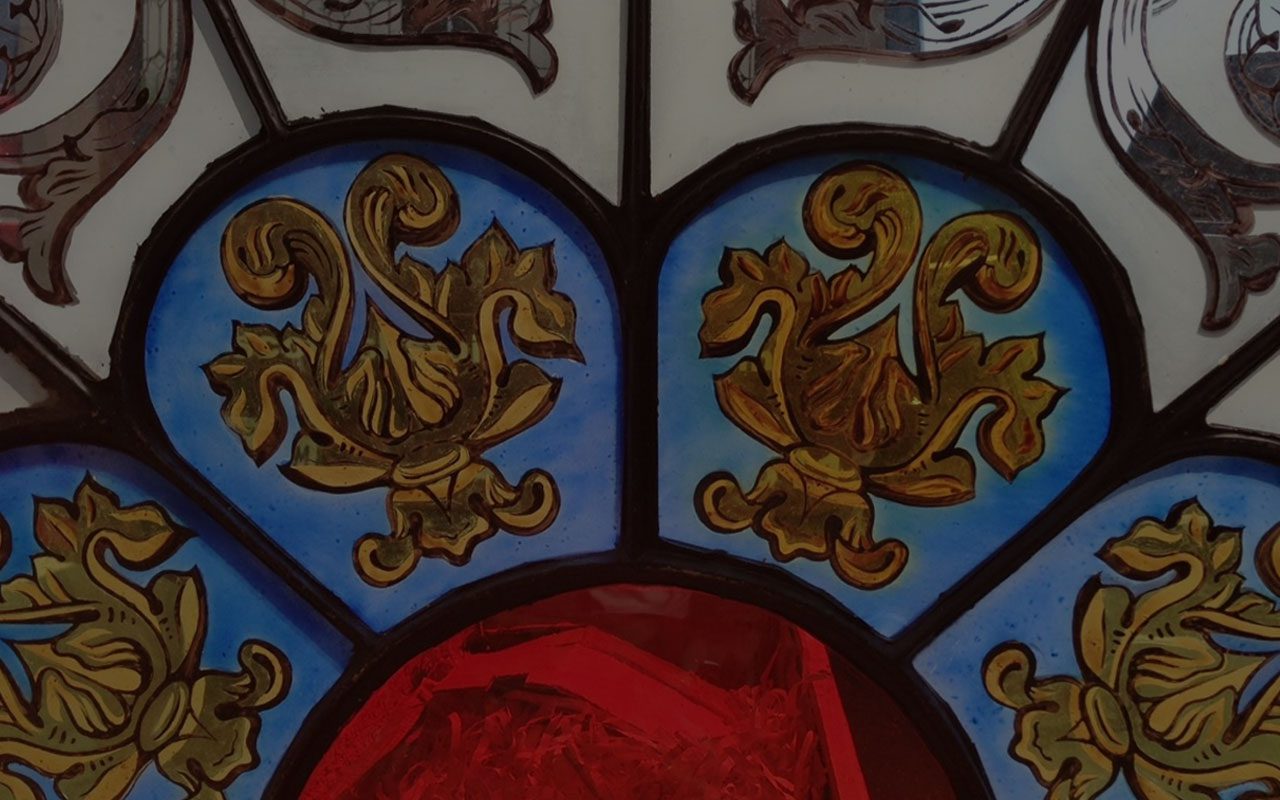
Stained glass has been a popular choice among religious and residential properties for some time. However, it’s becoming more and more popular among commercial properties throughout the globe. Commercial stained glass can range from stunning, historic pieces that have been repurposed to newly custom original windows built specifically for the property.
Stained glass can offer numerous benefits for commercial properties, acting as unique pieces of art for attracting potential clients, differentiating your business, improving property value, and much more. For commercial properties that have original, antique stained glass windows, restoration is required periodically in order to preserve these one-of-a-kind treasures. Stained glass restoration is the only way to properly conserve your commercial glass in order to maintain the exclusive benefits available.
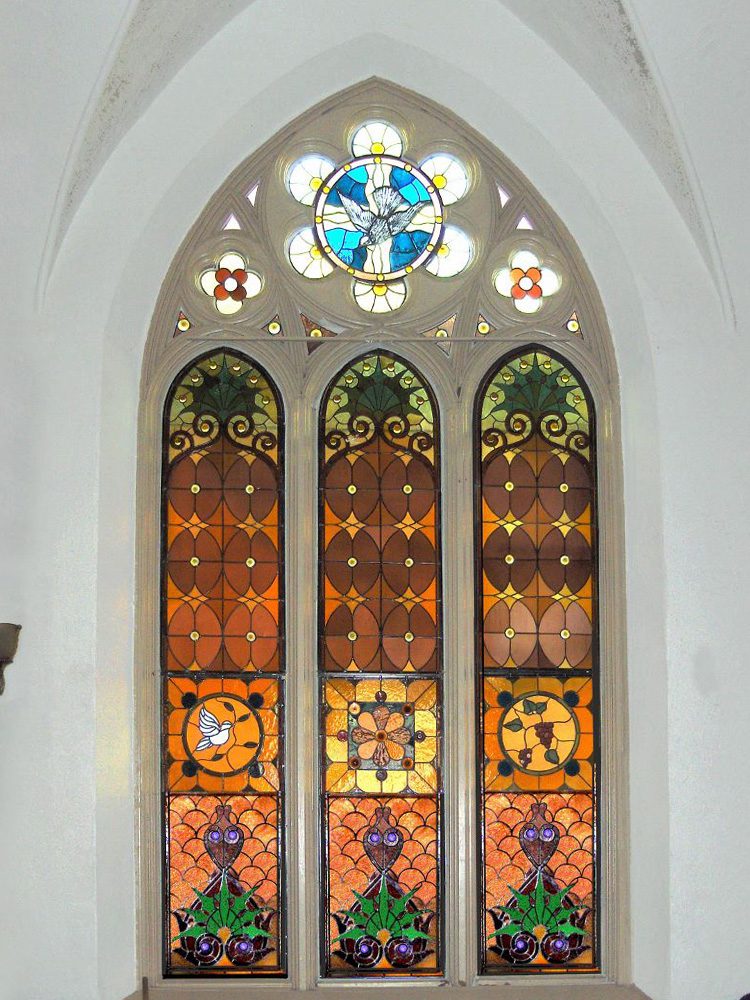
The Signs of Commercial Stained Glass Deterioration
Did you know that stained glass usually requires restoration around the 75-year to 100-year mark? However, original windows may require attention sooner if impacted by vandalism, severe storms, and other events that can accelerate the rate of deterioration. When it comes to determining if your commercial stained glass is ready for restoration, here are some of the tell-tale signs:
- Cracked, scratched, broken, or missing glass
- Brittle, soft, or cracked lead
- White dust or film appearing on the surface of your glass
- Concave or convex-shaped glass
- Discoloration or fading
- Yellowing plexiglass
- Light gaps
- Detached reinforcement bars
- Cracked, softened, or broken soldering joints
- Excessive dirt buildup
- Flaking, peeling, or faded paint
If you notice one or more of these symptoms in your windows or glass features, your stained glass is likely ready for restoration. Being proactive with your restoration efforts is crucial in order to save money, time, and resources. The longer you wait on starting the stained glass restoration process, the more damage can occur. If you wait too long, there might even be a chance that your restoration will cost more than replacing the window, resulting in a significant loss in its antique and historic value.
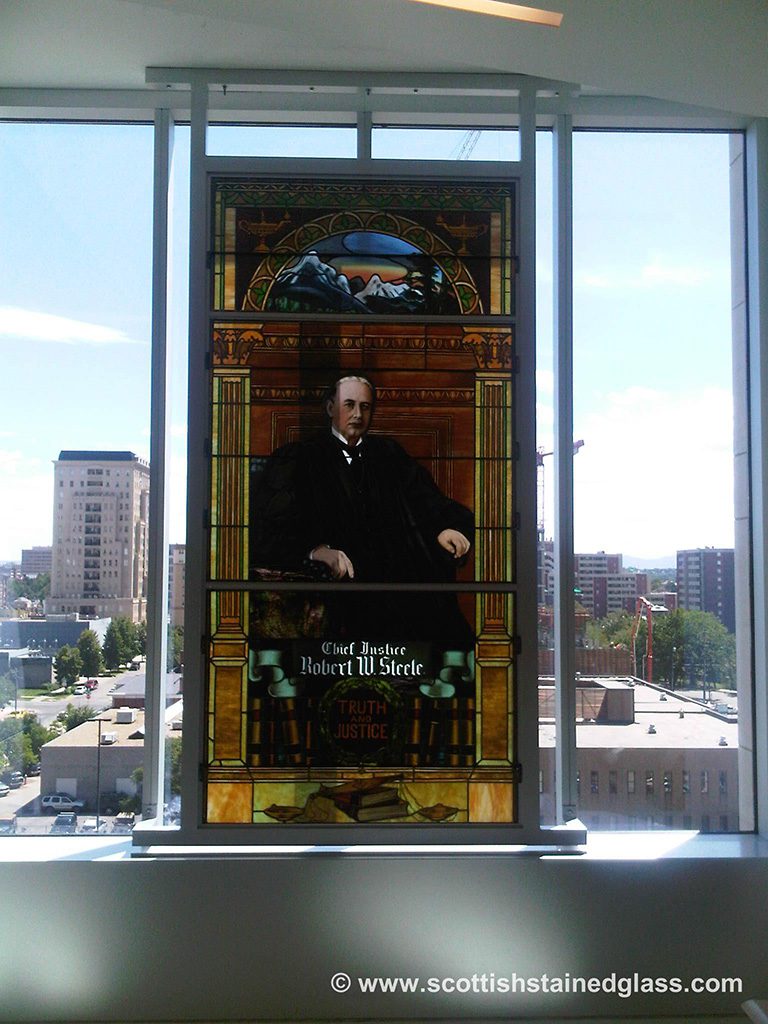
Why Does Aging Commercial Stained Glass Require Restoration?
Glass is a very fragile material although it is not usually impacted by moisture, weather, or gravity when it has the property support. If the glass itself doesn’t display any signs of damage, the problem is the lead.
Stained glass is held together with grooved leaded strips that are referred to as “came”. The pieces of glass that make up the window pattern are inserted into the grooves in the cames and are held securely in place. Even though lead is considered a heavy metal, it is actually very soft which makes it susceptible to the effects of gravity over time. Humidity, heat, and oxidation all play a significant role in the deterioration process of the structural integrity of the stained glass. Regardless of what the came is made of, lead, copper, or zinc, it will naturally deteriorate over time from exposure to the elements in addition to thermal expansion and contraction.
The larger your stained glass windows are, the more weight they’ll have to carry. Large commercial glass windows have a considerable weight to them which requires a lot of support. Once the lead begins to sag, a chain of events begins to slowly set into motion. If there are steel brace bars supporting the windows, they can eventually separate from the lead, adding additional concerns. This can actually be a safety hazard to any individuals who may be in proximity of the affected windows or features.
Other factors that can cause deterioration in your commercial glass include the aging of the window frame. Wood frames and sashes naturally decay over time, especially without proper maintenance and care. When a window frame decays, warps, rots, or loses its structural stability, this can accelerate the deterioration process causing windows to sag and glass to crack.
Some commercial properties tried protecting their stained glass windows from vandalism by installing plexiglass to the exterior. While this practice came from good intentions, it, unfortunately, has lead to accelerated deterioration rates among commercial glass. This is because the plexiglass or protective glass didn’t have proper ventilation, causing significant heat buildup to warp the stained glass windows. Plexiglass also yellows over time, impacting the appearance of the glass. Nowadays, commercial properties often use tempered safety glass as an alternative, but this will require proper framing and ventilation as well.
While there are a number of factors that can cause stained glass to deteriorate, the good news is that there is a solution. Since the effects of gravity and time on stained glass have been studied over the past century, advancements in modern restoration techniques enable a long-term solution for creating stronger, more stable, longer-lasting windows than when they were originally created.
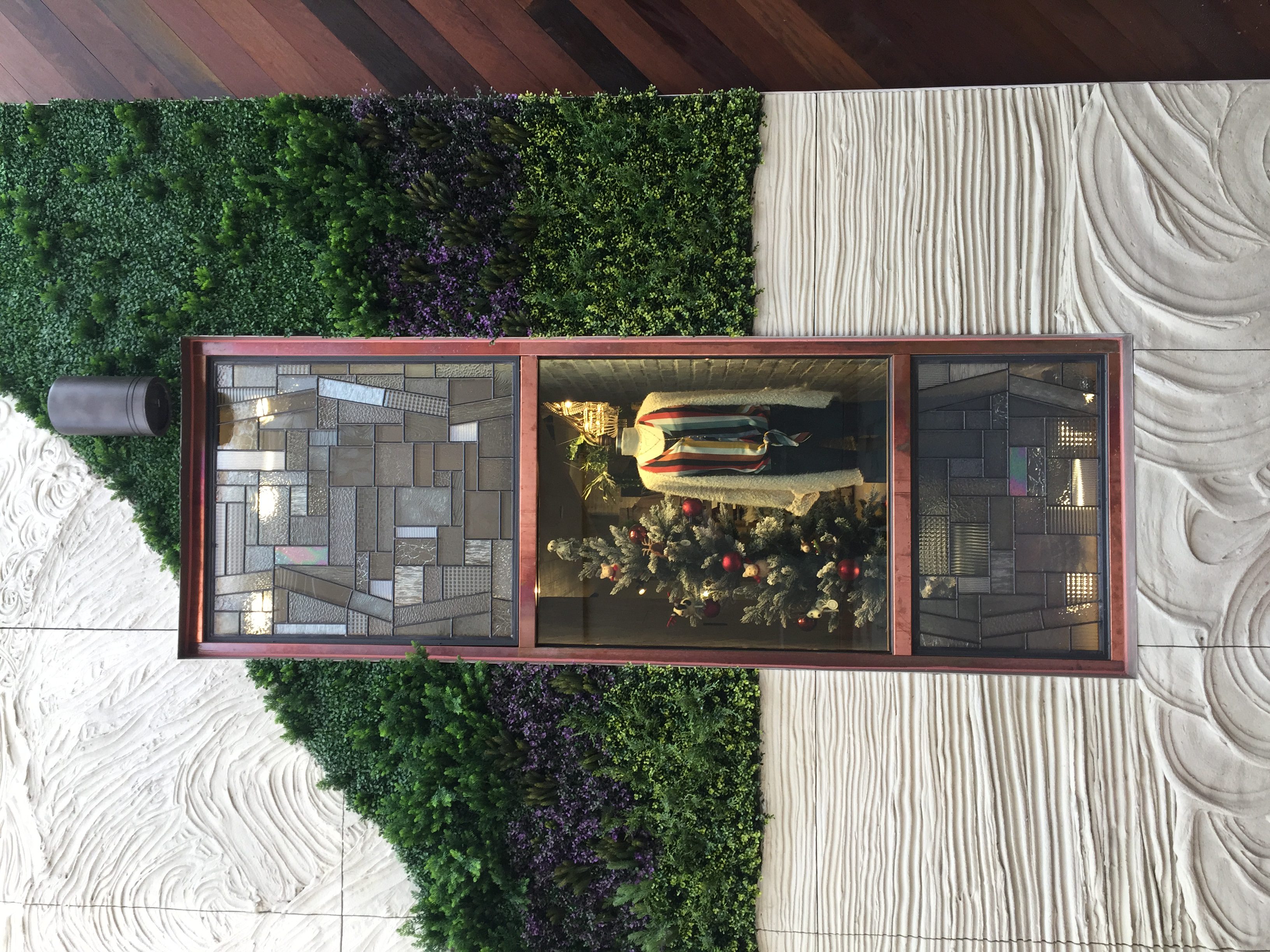
When to Consider Commercial Stained Glass Restoration
Signs of deterioration and damage can often be seen by the naked eye. Take the time to look over your commercial glass to check for any of the symptoms outlined above. It’s highly recommended to contact a professional at the first sign of trouble. Any repairs or restoration work should always be completed by an experienced stained glass restoration specialist.
Some repairs can be made without removing your stained glass. However, this depends on your glass’ unique situation. Inexperienced studios may try to re-brace your windows with new steel supports or flatten them back into place. While this low-cost alternative may seem like a better alternative to a more expensive full restoration, this type of service can actually cause significant pressure on the window leading to cracked glass and inevitable damage.
Proper restoration requires removing the windows completely. We recommend performing the restoration process at the first sign of buckling or bowing lead, even if all the glass elements seem to be in good condition still. Since it can become expensive to match the color, texture, and finish of a hundred-year-old glass, being proactive with your restoration efforts is the best call before any of the original glass becomes damaged. While minor sagging or bulging is common among older windows and may not require immediate restoration, these problems will only get worse. The sooner you start the commercial stained glass restoration process, the more money you’ll be able to save.
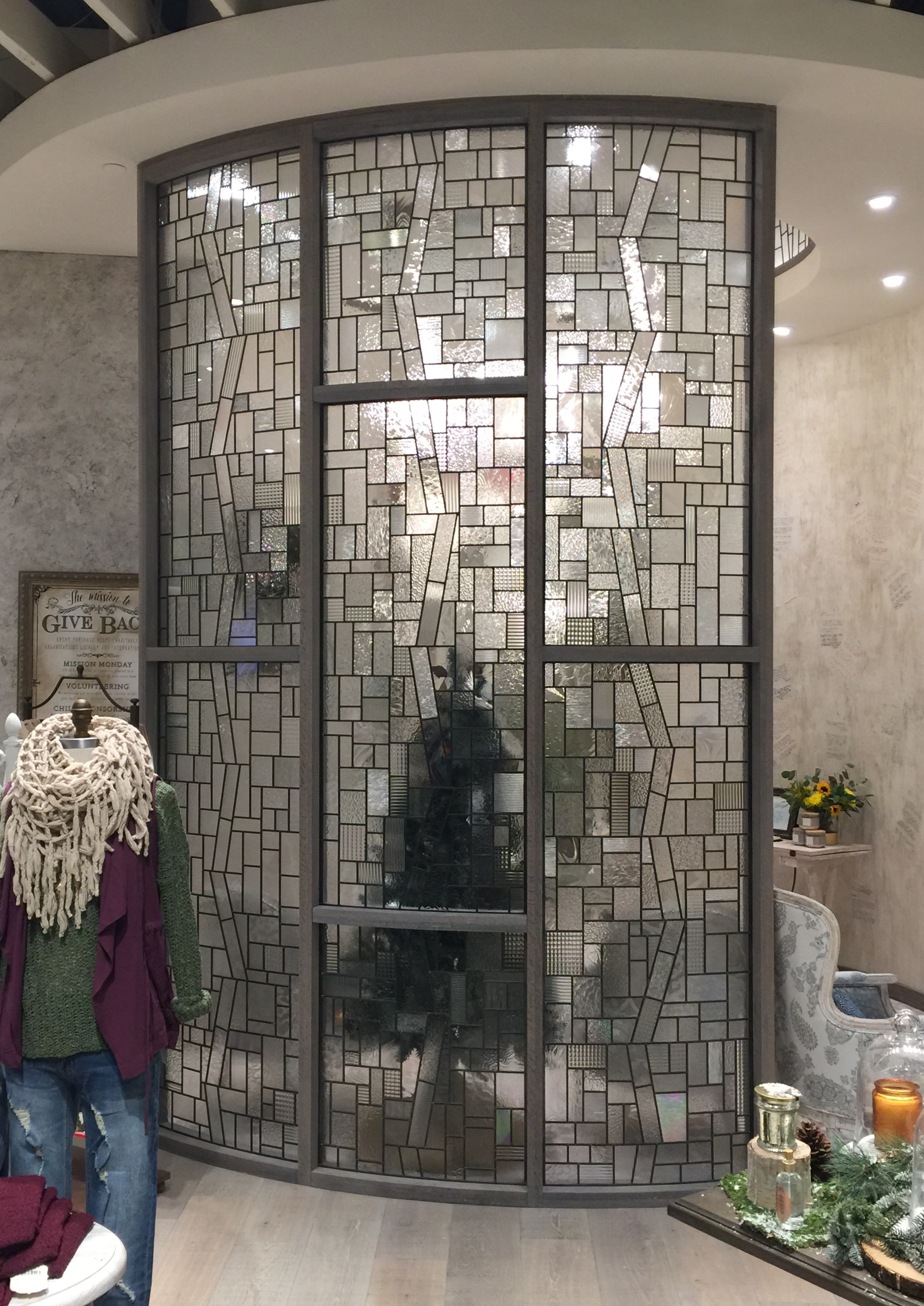
The Commercial Stained Glass Restoration Process
From our decades of experience, we’ve created our renowned restoration process for preserving and conserving various commercial glass from all time periods throughout the nation.
Stained Glass Assessment
We begin the glass restoration process with an on-site assessment. This assessment is completed by a master stained glass artisan who evaluates all of the underlying causes of deterioration. After evaluation, they create a comprehensive report that details the current condition of your glass. The assessment report will also outline a custom restoration plan based on the evaluation as well as a project timeline, estimate, and cost-benefit analysis. This also includes the current value of your glass in addition to its full restored value. We include as much information as possible so that you can make the most informed decision regarding your commercial stained glass.

Cleaning and Preparation
Once you’ve decided to proceed with your glass restoration, our team carefully removes your window or feature and replaces it with temporary panels. Your glass is then transported back to our stained glass studio where it soaks in a proprietary cleaning solution for up to two weeks.
The beauty of stained glass can drastically be impacted over time with the buildup of soot, grime, and even residue from candles or incense. Some stained glass windows are also covered with a layer of varnish or other types of lacquer which can cause yellowing over the years. Since acidic, abrasive cleaners cannot be used on stained glass, this soaking process is crucial to delicately clean your commercial glass. This soaking process is important for removing dirt buildup and allowing our team to easily disassemble it piece by piece.
Disassembly
Photographs, rubbings, and computer software are all crucial tools for stained glass restoration. We document the design and ensure everything can be perfectly reassembled after the restoration process. Our team catalogs each piece of glass that’s disassembled from your window. We always try to keep as much of the original glass as possible. Pieces of glass that are still in great condition are kept while the ones that require replacement are marked for fabrication.
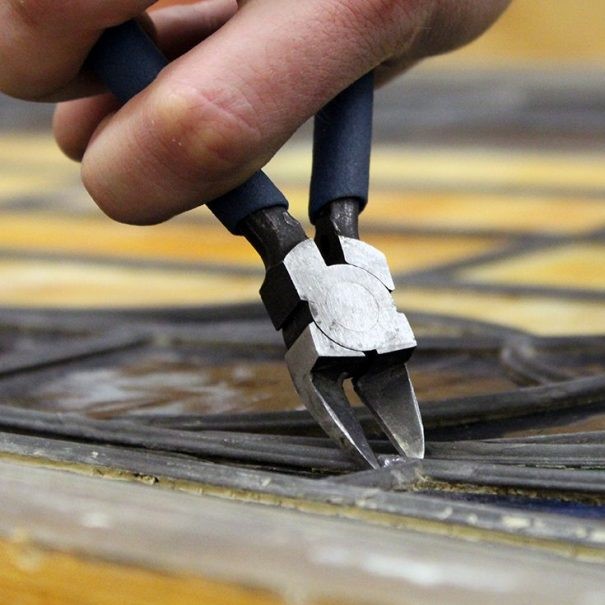
Glass Restoration
This process is utilized during restoration projects, however, our conservation projects often utilize an invisible mending process so that we can conserve the original without replacing glass pieces.
For restoration projects, any pieces of glass that are broken, cracked, or missing will require replacement. We always look for a 100% match among our vast glass inventory. However, it is very uncommon to find an existing perfect match. That’s because glassmakers typically guard their glassmaking secrets, making it almost impossible to find one in existence. If we are unable to find a perfect match, we’ll have it custom-created for proper restoration. We utilize numerous creative resources in order to make this possible.

Painted Glass Restoration
Painted glass restoration requires one of our painted glass conservation experts. The hand-painted glass is replicated based on technique, style, and color. They often spend hours mixing paints in order to achieve the perfect color match to the original. Through tedious research and resources including live models, our painted glass expert is capable of replicating virtually anything.
The restoration effort is then achieved through painting and firing in layers in order to create depth, shadowing, and luminosity. When restoring painted glass on either original Tiffany glass or Tiffany-style glass, there are always two layers of painted glass that need to be restored. These stained glass windows often have the two layers in order to create a three-dimensional look, with background colors on the first layer and detail work and more colors on the second layer.

Lead Recreation
Once our team has restored all of the glass pieces, we create a new lead came to replace the old one. Our proprietary lead mixture is specially manufactured to have a profile that’s similar to the existing lead but with a higher strength composition. We utilize an alloy that combines a fine-grain structure and high strength. The came starts with 100% pure lead in which small quantities of tin, copper, antimony, and bismuth. The finished product is still over 99% pure lead but offers better flexibility while maintaining a fine grain structure.
If extra strength is needed, 4% and 6% antimony can be utilized in order to increase the lead’s hardness. Since every project is unique, there may be cases where an off-the-shelf lead came isn’t available for matching the original lead profile. In these cases, one of our restoration experts will have a dye made and extrude the exact profile. In other cases whenever possible, the lead will also include steel that’s reinforced on the inside. Each lead joint is also soldered using a molten mixture of lead and tin.
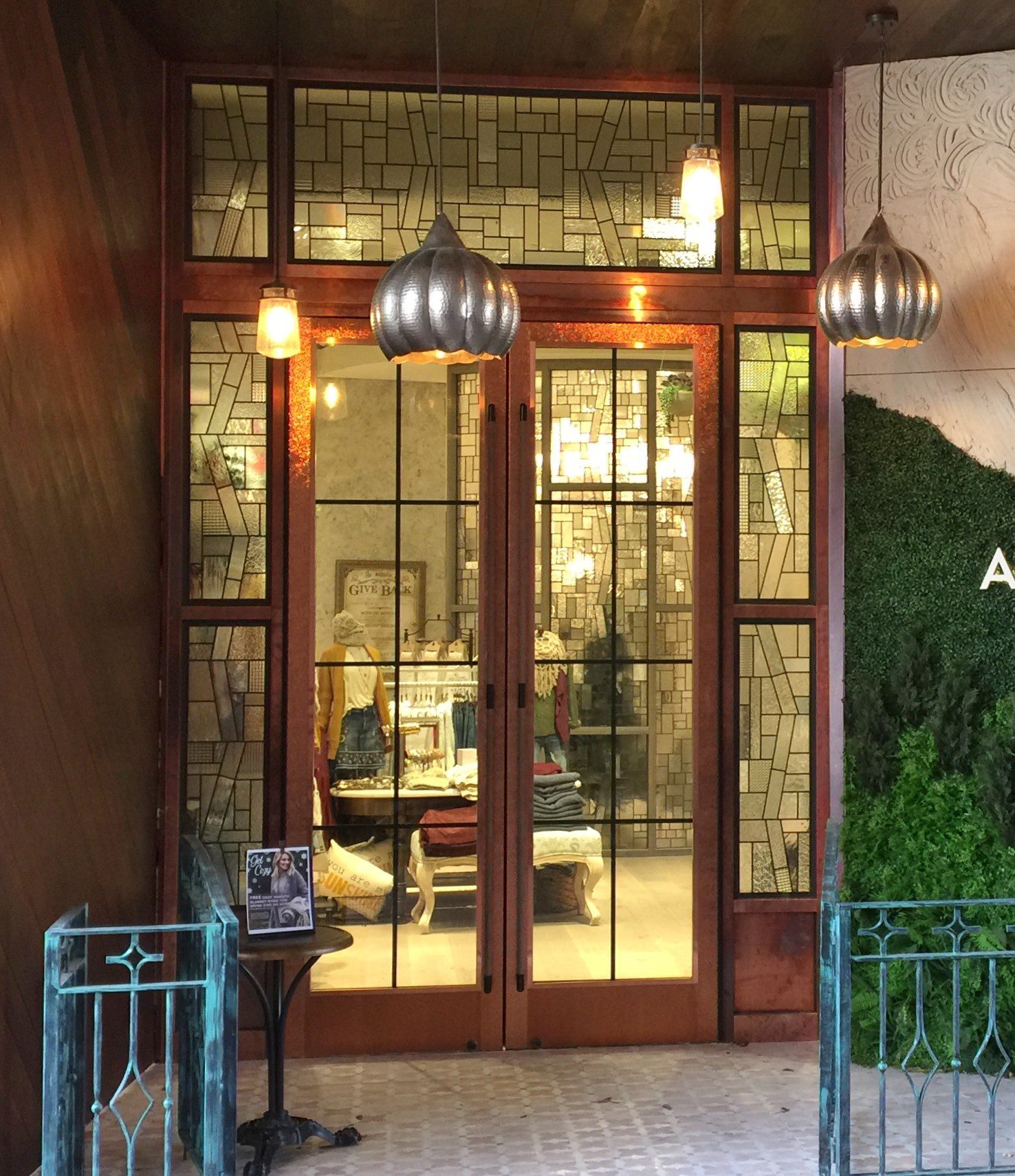
The Final Step
When both glass and lead components are restored, the panels are then cemented for extra strength and waterproofing. We utilize a specialized technique where we force a thin black cement between the lead and glass. Once the cement has been set and dried after a few days time, reinforcement bars are attached to the interior side of the panels if and where extra support is needed. The reinforcement bars must be left long enough to be installed throughout the framing of the window in order to allow the weight to be supported by the window frames. A common mistake is to cut off the rebars level with the outer edge of the panel or taper them at the edges. If there are no obvious ways to position the rebar without detriment to the design of the glass, the steel rebars can also be bent into any shape. Proper structural support will enable significant product longevity without the reappearance of the same structural problems originally caused by the softness of the lead and insufficient reinforcement.
Lastly, we complete a final cleaning and polishing to remove any unwanted cement or debris from the restoration. This ensures a brand-new appearance and luminosity for your treasured commercial glass.
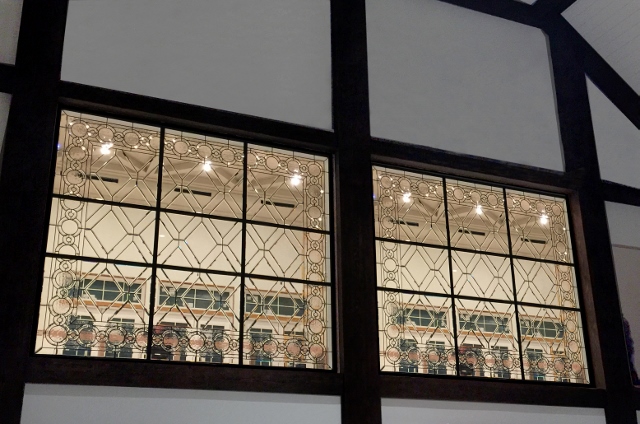
Commercial Glass Reinstallation
The finished product is returned to your business and reinstalled. Prior to reinstallation, we always evaluate if your window frames require restoration as well. Oftentimes they do – we ensure new framing is installed prior to stained glass reinstallation. There are also certain cases where a new protective glass can be installed as well. In a proper reinstallation, the weight of the stained glass must be evenly distributed into the framing around the glass. That’s where the steel brace bars come into play, helping improve structural integrity for decades to come.

Restored Glass Protection
Your newly installed stained glass will require protection from environmental concerns year-round. We install a protective clear glass on the exterior in order to provide a proper defense. However, this protective glass always has proper ventilation in order to avoid damage from excessive heat build-up. Venting is achieved either from the inside of your building or from the exterior. Both top and bottom vents are needed in order to allow heated air to properly escape from the top while allowing cooler air to be pulled from the bottom. Protective glass or polycarbonate should always be framed in on the outside in order to allow for occasional and removal and cleaning. We also offer window film services that can sometimes be added as an upgrade for further protection.
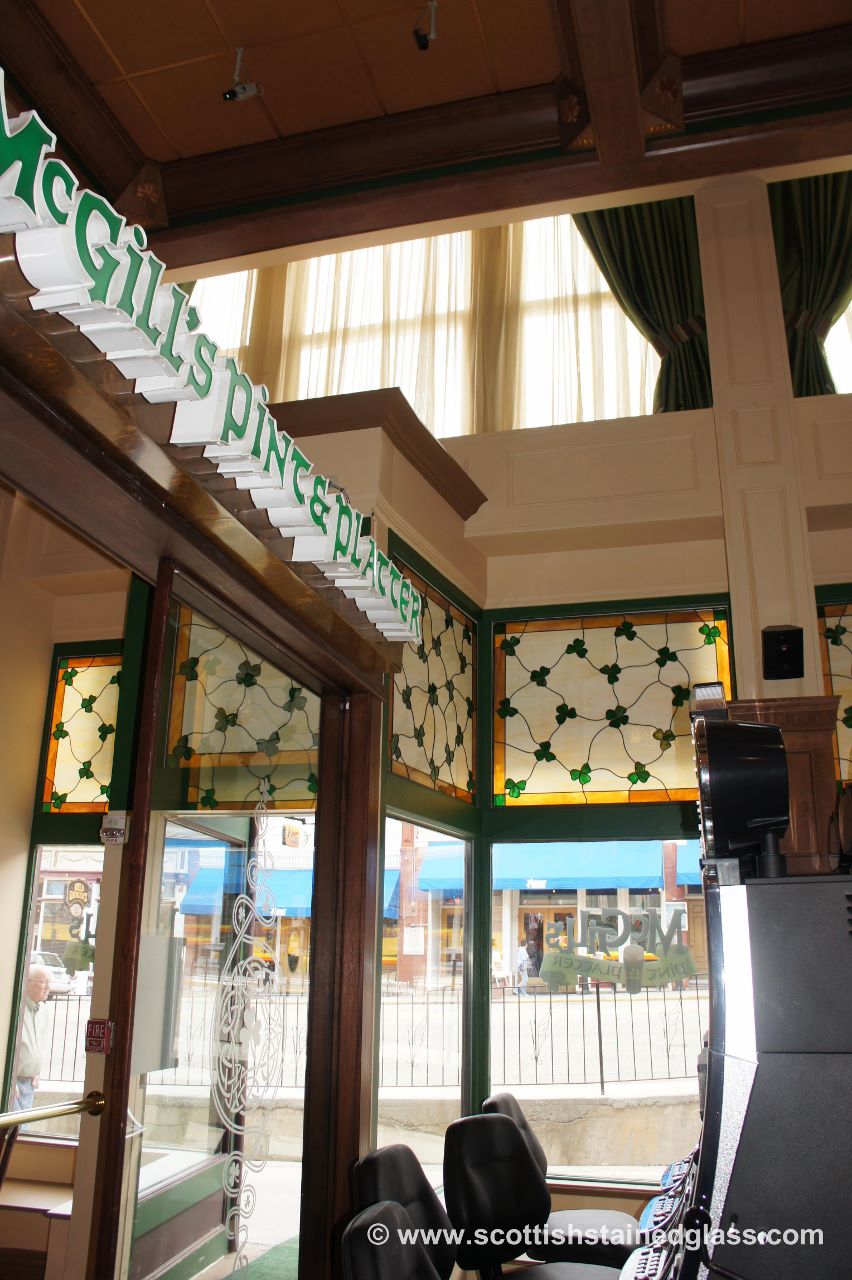
The Benefits of Commercial Stained Glass Restoration
Commercial stained glass restoration offers numerous benefits for your business. While the process can be extensive, require a significant financial investment, and can take months depending on the size, there are endless, exclusive benefits to take advantage of:
- Add at least another century of product life to your original glass
- Restore full antique value
- Improve overall property value
- Leading technological and engineering advancements for superior restoration
- Cost-effective alternative to stained glass replacement
- Preserved historical and sentimental value
- Iconic marketing and visual branding asset
- Improve client attraction and retention
- Differentiate your commercial property
- Great for special events, photo ops, and more
Whether you’d like to restore your original commercial glass or create custom designs to reap the benefits of commercial stained glass, our industry-leading team has you covered.
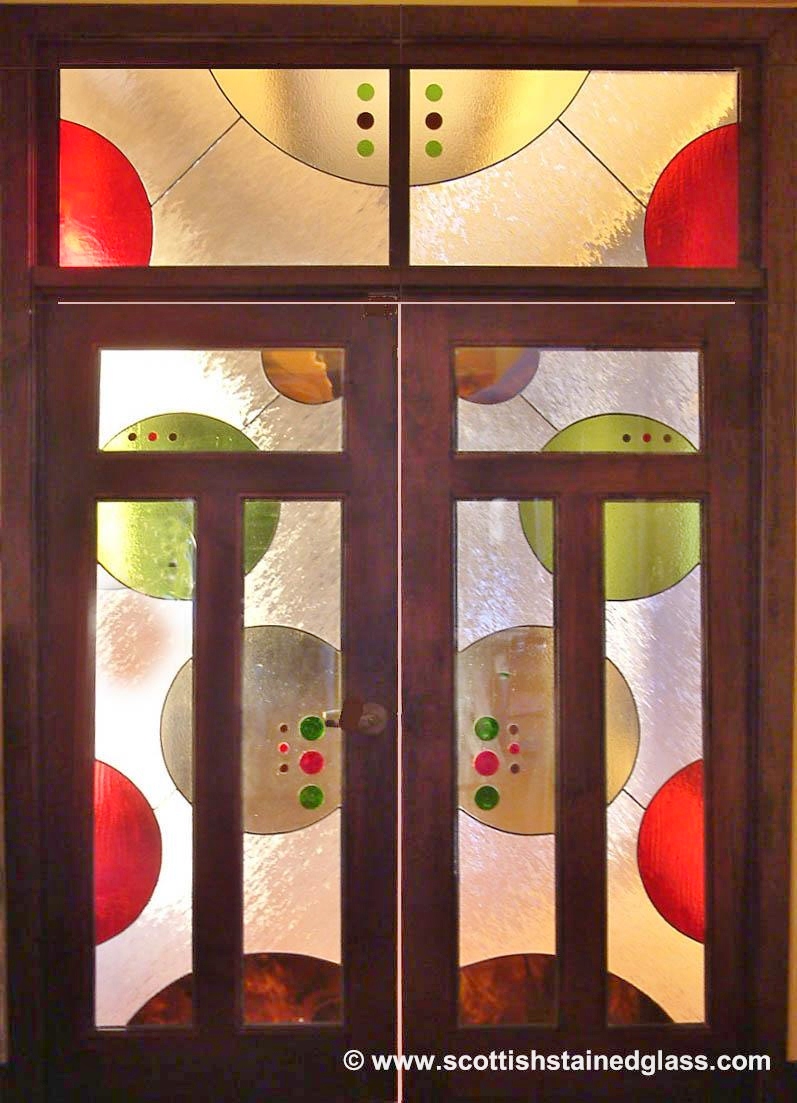
Finding the Right Commercial Glass Restoration Studio
Antique commercial stained glass is a part of your community’s history. Make sure to have only the best-qualified, experienced professionals work on your restoration project. Before starting any stained glass restoration project, it’s crucial to find the right studio to execute the work.
Tip: Is your stained glass restoration part of a larger renovation project? Have your stained glass removed prior to getting any other work started in order to eliminate the risk of any accidental damage. When working on larger, whole-property projects, taking the time to coordinate your restoration project at the beginning can save you significant money and resources.
Here is a list of questions you should ask when finding the right commercial glass restoration studio:
- Does the studio have an A+ rating with the BBB?
- Can they offer references? If so, always ask for at least three references for similar-sized projects.
- Do they have insurance and workman’s compensation? Normal liability insurance coverage should be $5 million.
- Do they have certification pursuant to the Toxic Substance Control Act? This is crucial for anyone working with disposing lead.
- Can you inspect other similar restoration projects that the studio has completed?
- Will there be full documentation of any work done for your records?
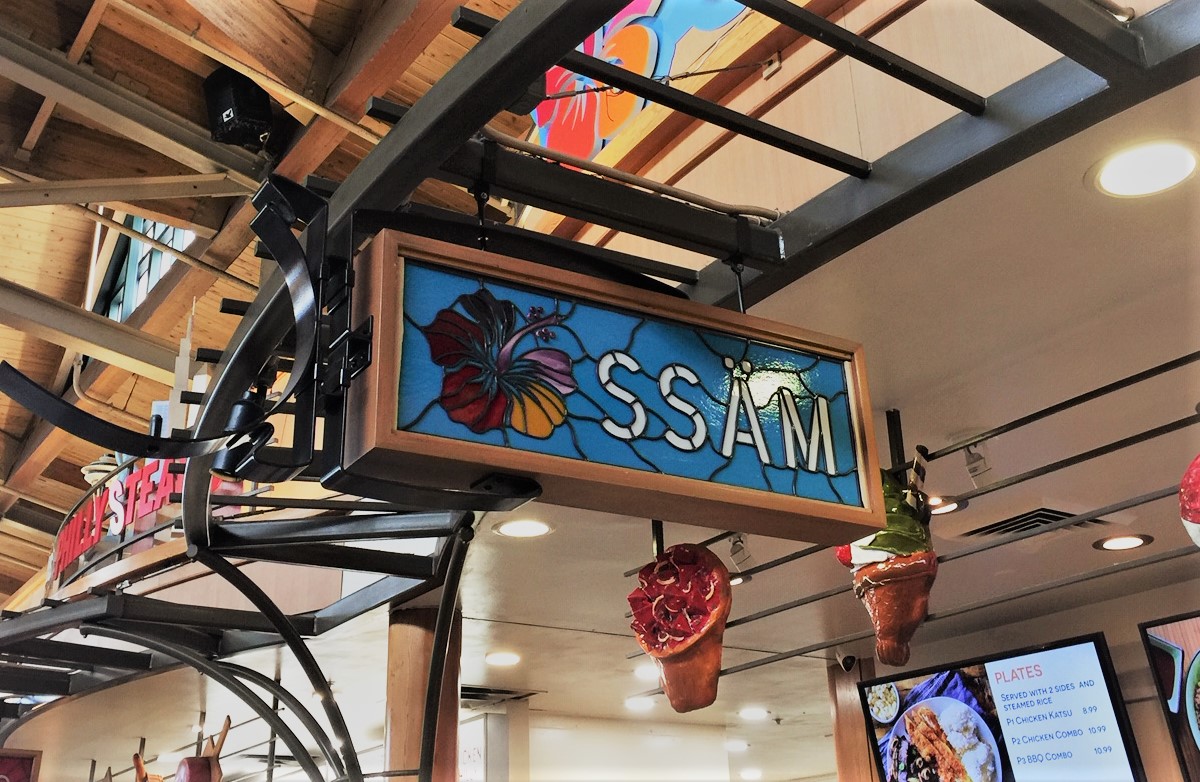
Insurance Claims for Commercial Stained Glass Restoration
Did you know that certain restoration projects can be covered by insurance? Situations like vandalism, severe storms, and other extreme environmental events may be covered by your property insurance. When working with your insurance company, it’s crucial to find a stained glass restoration expert to help with your claim process. While the insurance company does not have any intentional ill-intent, they are often inexperienced with antique stained glass claims and provide payouts that won’t effectively cover all the costs of your project.
Finding the right stained glass restoration studio is an important first step when working through an insurance claim process. Our team has worked with many commercial and religious properties in their insurance process and is happy to help you with yours. Having a comprehensive, proper evaluation of the antique value of your glass’ current condition versus its restored condition is crucial for your insurance company.
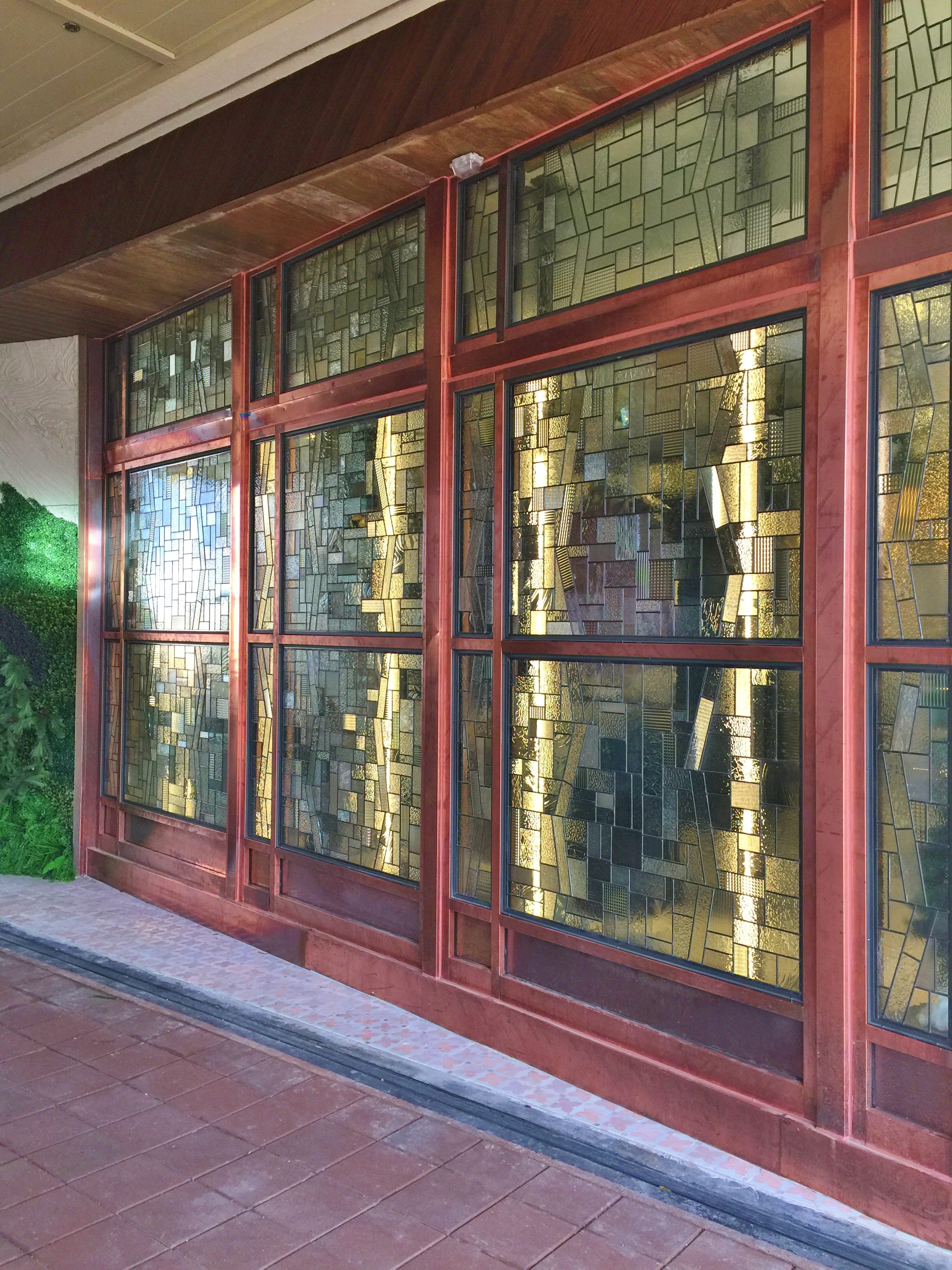
Exterior Protective Systems for Protecting Your Stained Glass
We proudly offer exclusive aluminum systems for defending your commercial stained glass. Similar to commercial storefront systems, our systems are modern, sleek, and can be installed to any building type. With the capability of housing many different protective covers like plexiglass, tempered, plate, and laminate glass, you can choose the perfect option for your specific needs.
Our aluminum framing systems are available in various colors including dark bronze, white, metal finish, and custom color options. They have ventilation built into the frame, creating a less labor-intensive project while ensuring your stained glass has the proper ventilation it needs to avoid any heat build-up.
These systems offer other incredible benefits including low maintenance needs and easy replacement. Since the protective coverings defend both your stained glass and existing wooden frames, you’ll no longer need to paint them periodically from weather damage. Another benefit is that if your protective glazing is ever damaged from natural disasters, vandalism, or other threats, you can easily remove and replace this in minutes without changing the system. Enjoy a permanent, maintenance-free solution for defending your commercial stained glass.
Work With the Nation’s Leading Commercial Stained Glass Restoration Expert
Commercial Art Glass is honored to be the leading commercial stained glass restoration expert serving the nation. We would love the opportunity to work on your next commercial stained glass restoration project and help ensure all the exclusive benefits this service has to offer. Whether you have an antique, historic window that requires full conservation or original stained glass that’s ready for restoration, we’ve got you covered. For more information regarding commercial glass restoration or if you’d like to schedule your on-site assessment, please contact us!
